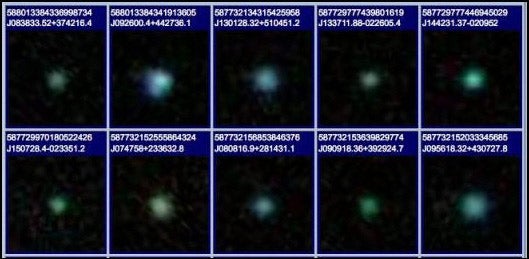On September 10 at the Joint European and National Astronomy Meeting (JENAM 2010), Ricardo Amorin of the Instituto de Astrofisica de Andalucia presented a talk explaining the nature of strange so-called Green Pea galaxies. First discovered in 2007 by amateur stargazers, scientists are now discovering that these extraordinary and extremely compact star cities have low amounts of complex elements after being diluted by streams of gas and strong supernova winds.
Lead scientist Amorin said, “This Green Pea discovery is a fabulous example of how normal citizens, ‘astronomy lovers’, can help scientists with their collective efforts. They discuss the science with professional astronomers, and have written an excellent Wikipedia entry about Green Pea galaxies, which presents a lot of information to people of the world.”
Hobby stargazers first classified this new type of galaxies. The online project Galaxy Zoo and Galaxy Zoo 2 asked interested members of the public to help sort through a vast depository of night sky images produced by the Sloan Digital Sky Survey. Categorizing galaxy types is important to the understanding of the evolution of the universe but also difficult because of the ambiguous shape of many. Astronomers turned to the online community for help, and citizen scientists flocked to sift through the images and look for galaxy types. Within 24 hours of launch, the site was receiving an astonishing 70,000 classifications an hour.
These citizen scientists discovered a strange type of galaxy that did not fit with previously known types. Small in size and green in color, they were soon named “Green Pea” galaxies. They appear to be compact low-mass galaxies undergoing intense star formation, and being around1.5 to 5 billion light-years distant indicates that this is a brief but extreme stage of their evolution.
Green Pea galaxies are now known to be “metal-poor” — metals in this astronomical sense meaning any element other than hydrogen and helium. The study presented September 10 suggests that gas gravitationally attracted from the outskirts of the Green Pea galaxies or beyond, combined with shockwaves from supernova explosions, are likely causes. Amorin explained, “Discovering Green Pea galaxies has opened a new window to investigate galaxy evolution and star formation in the early universe.”
Green Pea galaxies aren’t the only citizen science successes to come from Galaxy Zoo. In 2007, Dutch school teacher Hanny van Arkel was categorizing galaxies for the project when she came across a very strange object. This was soon named Hanny’s Voorwerp, from the Dutch for “Hanny’s Object.” This strange phenomenon baffled scientists, and it was only in June 2010 that a possible explanation — a supermassive black hole in a nearby galaxy emitting radiation and making a cloud of gas glow — was provided. The community of amateur astronomers have cooperated to make an educational webcomic about this adventure, called “Hanny and the Mystery of the Voorwerp.”
Amorin concluded, “The Galaxy Zoo volunteers have put science very close to the citizens. This is an active and powerful way to spread science.”
The latest incarnation of Galaxy Zoo uses data provided by the famous Hubble Space Telescope, to peer deeper into the universe than before. Perhaps even more citizen science discoveries are just around the corner.










